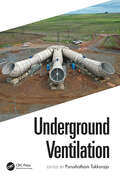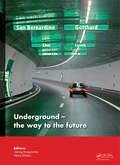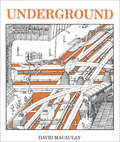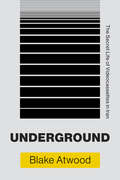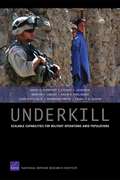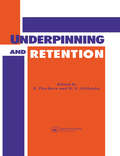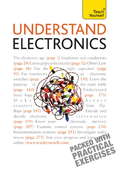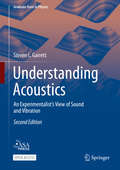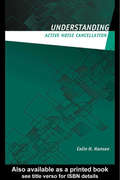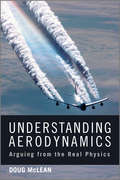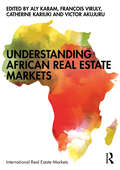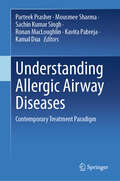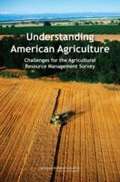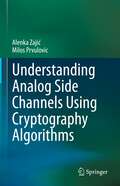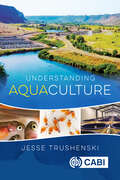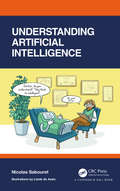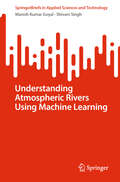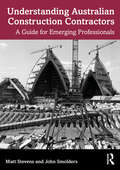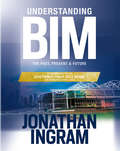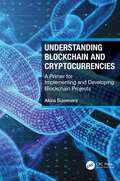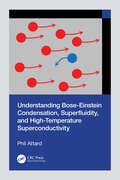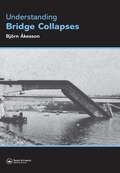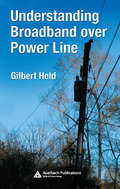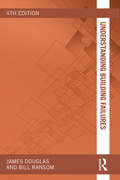- Table View
- List View
Underground Ventilation: Proceedings of the 19th North American Mine Ventilation Symposium ((NAMVS 2023, 17-22 June 2023, Rapid City, South Dakota, USA)
by Purushotham TukkarajaUnderground Ventilation contains the proceedings of the 19th North American Mine Ventilation Symposium held at the South Dakota School of Mines & Technology (South Dakota Mines) in Rapid City, South Dakota, June 17-22, 2023. South Dakota Mines organized this symposium in collaboration with the Underground Ventilation Committee (UVC) of the Society for Mining, Metallurgy & Exploration (SME). The Mine Ventilation Symposium series has always been a premier forum for ventilation experts, practitioners, educators, students, regulators, and suppliers from around the world to exchange knowledge, ideas, and opinions. Underground Ventilation features sixty-seven selected technical papers in a wide range of ventilation topics including: auxiliary and primary systems, mine fans, case studies, computational fluid dynamics applications, diesel particulate control, electric machinery, mine cooling and refrigeration, mine dust monitoring and control, mine fires and explosion prevention, mine gases, mine heat, mine ventilation and automation, occupational health and safety, renewable/alternative energy, monitoring and measurement, network analysis and optimization, and planning and design.
Underground. The Way to the Future
by Georg Anagnostou Heinz EhrbarUnderground � the way to the future was the motto of the World Tunnel Congress 2013 in Geneva, Switzerland. The use of underground space has gained importance during the last years due to the tremendous global urbanization, the high demand on transportation capacities and energy production. All this result in a wider range of use of underground spa
Underground: El Subsuelo
by David MacaulayDavid Macaulay takes us on a visual journey through a city's various support systems by exposing a typical section of the underground network and explaining how it works. We see a network of walls, columns, cables, pipes and tunnels required to satisfy the basic needs of a city's inhabitants.
Underground: The Secret Life of Videocassettes in Iran (Infrastructures)
by Blake AtwoodHow Iranians forged a vibrant, informal video distribution infrastructure when their government banned all home video technology in 1983.In 1983, the Iranian government banned the personal use of home video technology. In Underground, Blake Atwood recounts how in response to the ban, technology enthusiasts, cinephiles, entrepreneurs, and everyday citizens forged an illegal but complex underground system for video distribution. Atwood draws on archival sources including trade publications, newspapers, memoirs, films, and laws, but at the heart of the book lies a corpus of oral history interviews conducted with participants in the underground. He argues that videocassettes helped to institutionalize the broader underground within the Islamic Republic.As Atwood shows, the videocassette underground reveals a great deal about how people construct vibrant cultures beneath repressive institutions. It was not just that Iranians gained access to banned movies, but rather that they established routes, acquired technical knowledge, broke the law, and created rituals by passing and trading plastic videocassettes. As material objects, the videocassettes were a means of negotiating the power of the state and the agency of its citizens. By the time the Ministry of Culture and Islamic Guidance lifted the ban in 1994, millions of videocassettes were circulating efficiently and widely throughout the country. The very presence of a video underground signaled the failure of state policy to regulate media. Embedded in the informal infrastructure--even in the videocassettes themselves--was the triumph of everyday people over the state.
Underkill: Scalable Capabilities for Military Operations amid Populations
by David C. Gompert David R. Frelinger Martin C. Libicki Stuart E. Johnson John GordonThe U.S. military is ill-equipped to strike at extremists who hide in populations. Using deadly force against them can harm and alienate the very people whose cooperation U.S. forces are trying to earn. To solve this problem, a new RAND study proposes a "continuum of force"--a suite of capabilities that includes sound, light, lasers, cell phones, and video cameras. These technologies are available but have received insufficient attention.
Underpinning and Retention
by S. Thorburn G. S. LittlejohnVarious underpinning methods exist, and choosing a particular method or selection of methods is the job of the engineer. Consistent with the underpinning procedure is the need to retain the affected structure plus the surrounding ground and/or buildings. This book will offer advice on how to chose the correct procedure.
Understand Electronics: Teach Yourself
by Malcolm PlantUnderstand Electronics will enable you to grasp the fundamental concepts of electronics as well as the more complex principles. Offering support and clarity throughout, this book covers everything from voltage, dividers and resisors to logic gates and Boolean algebra. You will gain a solid understanding and feel confident in demonstrating your knowledge.NOT GOT MUCH TIME?One, five and ten-minute introductions to key principles to get you started.AUTHOR INSIGHTSLots of instant help with common problems and quick tips for success, based on the author's many years of experience.vTEST YOURSELFTests in the book and online to keep track of your progress.EXTEND YOUR KNOWLEDGEExtra online articles at www.teachyourself.com to give you a richer understanding of electronics.FIVE THINGS TO REMEMBERQuick refreshers to help you remember the key facts.TRY THISInnovative exercises illustrate what you've learnt and how to use it.
Understand Electronics: Teach Yourself (TY Science)
by Malcolm PlantUnderstand Electronics will enable you to grasp the fundamental concepts of electronics as well as the more complex principles. Offering support and clarity throughout, this book covers everything from voltage, dividers and resisors to logic gates and Boolean algebra. You will gain a solid understanding and feel confident in demonstrating your knowledge. NOT GOT MUCH TIME? One, five and ten-minute introductions to key principles to get you started. AUTHOR INSIGHTS Lots of instant help with common problems and quick tips for success, based on the author's many years of experience.v TEST YOURSELF Tests in the book and online to keep track of your progress. EXTEND YOUR KNOWLEDGE Extra online articles at www.teachyourself.com to give you a richer understanding of electronics. FIVE THINGS TO REMEMBER Quick refreshers to help you remember the key facts. TRY THIS Innovative exercises illustrate what you've learnt and how to use it.
Understanding Acoustics: An Experimentalist’s View of Sound and Vibration (Graduate Texts in Physics)
by Steven L. GarrettThis open access textbook, like Rayleigh’s classic Theory of Sound, focuses on experiments and on approximation techniques rather than mathematical rigor. The second edition has benefited from comments and corrections provided by many acousticians, in particular those who have used the first edition in undergraduate and graduate courses. For example, phasor notation has been added to clearly distinguish complex variables, and there is a new section on radiation from an unbaffled piston. Drawing on over 40 years of teaching experience at UCLA, the Naval Postgraduate School, and Penn State, the author presents a uniform methodology, based on hydrodynamic fundamentals for analysis of lumped-element systems and wave propagation that can accommodate dissipative mechanisms and geometrically-complex media. Five chapters on vibration and elastic waves highlight modern applications, including viscoelasticity and resonance techniques for measurement of elastic moduli, while introducing analytical techniques and approximation strategies that are revisited in nine subsequent chapters describing all aspects of generation, transmission, scattering, and reception of waves in fluids. Problems integrate multiple concepts, and several include experimental data to provide experience in choosing optimal strategies for extraction of experimental results and their uncertainties. Fundamental physical principles that do not ordinarily appear in other acoustics textbooks, like adiabatic invariance, similitude, the Kramers-Kronig relations, and the equipartition theorem, are shown to provide independent tests of results obtained from numerical solutions, commercial software, and simulations. Thanks to the Veneklasen Research Foundation, this popular textbook is now open access, making the e-book available for free download worldwide. Provides graduate-level treatment of acoustics and vibration suitable for use in courses, for self-study, and as a referenceHighlights fundamental physical principles that can provide independent tests of the validity of numerical solutions, commercial software, and computer simulationsDemonstrates approximation techniques that greatly simplify the mathematics without a substantial decrease in accuracyIncorporates a hydrodynamic approach to the acoustics of sound in fluids that provides a uniform methodology for analysis of lumped-element systems and wave propagationEmphasizes actual applications as examples of topics explained in the textIncludes realistic end-of-chapter problems, some including experimental data, as well as a Solutions Manual for instructors.Features “Talk Like an Acoustician“ boxes to highlight key terms introduced in the text.
Understanding Active Noise Cancellation
by Colin H. HansenUnderstanding Active Noise Cancellation Provides a concise introduction to the fundamentals and applications of active control of vibration and sound for the non-expert. It is also a useful quick reference for the specialist engineer. The book emphasises the practical applications of technology, and complex control algorithms and structures are onl
Understanding Aerodynamics: Arguing from the Real Physics (Aerospace Series #69)
by Doug McLeanMuch-needed, fresh approach that brings a greater insight into the physical understanding of aerodynamics Based on the author’s decades of industrial experience with Boeing, this book helps students and practicing engineers to gain a greater physical understanding of aerodynamics. Relying on clear physical arguments and examples, Mclean provides a much-needed, fresh approach to this sometimes contentious subject without shying away from addressing "real" aerodynamic situations as opposed to the oversimplified ones frequently used for mathematical convenience. Motivated by the belief that engineering practice is enhanced in the long run by a robust understanding of the basics as well as real cause-and-effect relationships that lie behind the theory, he provides intuitive physical interpretations and explanations, debunking commonly-held misconceptions and misinterpretations, and building upon the contrasts provided by wrong explanations to strengthen understanding of the right ones. Provides a refreshing view of aerodynamics that is based on the author’s decades of industrial experience yet is always tied to basic fundamentals. Provides intuitive physical interpretations and explanations, debunking commonly-held misconceptions and misinterpretations Offers new insights to some familiar topics, for example, what the Biot-Savart law really means and why it causes so much confusion, what “Reynolds number” and “incompressible flow” really mean, and a real physical explanation for how an airfoil produces lift. Addresses "real" aerodynamic situations as opposed to the oversimplified ones frequently used for mathematical convenience, and omits mathematical details whenever the physical understanding can be conveyed without them.
Understanding African Real Estate Markets (Routledge International Real Estate Markets Series)
by Aly Karam François Viruly Catherine Kariuki Victor A. AkujuruThis book brings together a broad range of research that interrogates how real estate market analysis, finance, planning, and investment for residential and commercial developments across the African continent are undertaken. In the past two decades, African real estate markets have rapidly matured, creating the conditions for new investment opportunities which has increased the demand for a deeper understanding of the commercial and residential markets across the continent. The chapters consider issues that pertain to formal real estate markets and the critical relationship between formal and informal property markets on the continent. With contributing authors from South Africa, Ghana, Nigeria, Uganda, Kenya, and Tanzania, the book considers the achievements of African real estate markets while also highlighting the complex central themes such as underdeveloped land tenure arrangements, the availability of finance in both the commercial and residential sectors, rapidly growing urban areas, and inadequate professional skills. This book is essential reading for students in real estate, land management, planning, finance, development, and economics programs who need to understand the nuances of markets in the African context. Investors and policy makers will learn a lot reading this book too.
Understanding Allergic Airway Diseases: Contemporary Treatment Paradigm
by Kamal Dua Ronan MacLoughlin Kavita Pabreja Sachin Kumar Singh Parteek Prasher Mousmee SharmaThe book explores the intersection of nanotechnology and allergic airway diseases. With a focus on diagnosis and management, each chapter delves into specific areas of interest. Beginning with an introduction to the diseases, the book progresses to uncover the pathophysiology and immunology underlying allergic airway diseases. The epidemiology chapter provides insights into the prevalence and impact of these conditions. A significant portion of the book is dedicated to nanotechnology applications, with chapters on metal and metal oxide nanoparticles, nanomicelles, carbon nanotubes, liposomes, polymeric nanoparticles, solid lipid nanoparticles, dendrimers, nanofibers, and quantum dots. These chapters delve into the potential of these nanomaterials in managing allergic airway diseases, highlighting their unique properties, and promising therapeutic approaches. Finally, the book concludes with a chapter on future directions, exploring emerging trends and potential advancements in the field. This book will be a valuable resource for academics, caregivers, researchers, and industry professionals working in the field of airway allergic diseases. It includes translational and clinical researchers, under-graduates and postgraduates (Masters), PhDs, and post-doctoral researchers of various disciplines, including pharmaceutical sciences, biotechnology, immunology, and medical and health sciences.
Understanding American Agriculture: Challenges for the Agricultural Resource Management Survey
by National Research Council of the National AcademiesThe National Academies Press (NAP)--publisher for the National Academies--publishes more than 200 books a year offering the most authoritative views, definitive information, and groundbreaking recommendations on a wide range of topics in science, engineering, and health. Our books are unique in that they are authored by the nation's leading experts in every scientific field.
Understanding Analog Side Channels Using Cryptography Algorithms
by Alenka Zajić Milos PrvulovicThis book offers the latest research results on analog side channels and their usage in cybersecurity. It demystifies analog side channels and demonstrates new use cases for them. The first part of this book discusses how analog side channels are generated, the physics behind it, the modeling and measurements of analog side channels, and their analogies to wireless communication systems. The second part of this book introduces new applications that benefit from leveraging side channels. In addition to breaking cryptography algorithms, it demonstrates how analog side channels can be used for malware detection, program profiling, hardware profiling, hardware/software attestation, hardware identification, and hardware Trojan detection.Side channel is one of the methods for obtaining information about program execution. Traditionally, they are used in computer science to extract information about a key in cryptographic algorithms. What makes them different from other ways of extracting information about program execution is that side channels rely on how a system implements program execution, rather than what the program’s algorithm specifies. Analog side channels are particularly powerful because they are not easy to suppress or detect that someone is collecting information from the system. Although they are very powerful tools, they are poorly understood.This book targets advanced level students in computer science and electrical engineering as a textbook. Researchers and professionals working with analog side channels, how to model them, measure them, improve signal to noise ratio, and invent new signal processing techniques can also use this book. Computer scientists and engineers who want to learn new applications of side channels to improve system security, new techniques for breaking cryptography keys, new techniques for attestation, and new techniques for hardware Trojan detection will also want to purchase this book.
Understanding Aquaculture
by Jesse TrushenskiRoughly half the seafood we eat comes from farms, and yet many consumers remain hesitant, even resistant, to buying farmed fish. Aquaculture is compared with both terrestrial agriculture and capture fisheries and has endured considerable, often unfounded, criticism. Understanding Aquaculture addresses the controversial aspects of aquaculture, answering common questions about the industry and farmed seafood. Are farmed fish safe to eat? Are wild fish more nutritious? Do fish farms pollute the environment? Understanding Aquaculture sets the record straight for the world's most important source of seafood. Aquaculture is critical to food security, both now and in the future, and an informed and supportive public is needed to ensure its potential is fully realized. Informative and engaging, Understanding Aquaculture is a thoroughly researched resource for students and practitioners, but manages to put the facts within reach of casual readers.
Understanding Artificial Intelligence
by Nicolas SabouretArtificial Intelligence (AI) fascinates, challenges and disturbs us. There are many voices in society that predict drastic changes that may come as a consequence of AI – a possible apocalypse or Eden on earth. However, only a few people truly understand what AI is, what it can do and what its limitations are. Understanding Artificial Intelligence explains, through a straightforward narrative and amusing illustrations, how AI works. It is written for a non-specialist reader, adult or adolescent, who is interested in AI but is missing the key to understanding how it works. The author demystifies the creation of the so-called "intelligent" machine and explains the different methods that are used in AI. It presents new possibilities offered by algorithms and the difficulties that researchers, engineers and users face when building and using such algorithms. Each chapter allows the reader to discover a new aspect of AI and to become fully aware of the possibilities offered by this rich field.
Understanding Atmospheric Rivers Using Machine Learning (SpringerBriefs in Applied Sciences and Technology)
by Manish Kumar Goyal Shivam SinghThis book delves into the characterization, impacts, drivers, and predictability of atmospheric rivers (AR). It begins with the historical background and mechanisms governing AR formation, giving insights into the global and regional perspectives of ARs, observing their varying manifestations across different geographical contexts. The book explores the key characteristics of ARs, from their frequency and duration to intensity, unraveling the intricate relationship between atmospheric rivers and precipitation. The book also focus on the intersection of ARs with large-scale climate oscillations, such as El Niño and La Niña events, the North Atlantic Oscillation (NAO), and the Pacific Decadal Oscillation (PDO). The chapters help understand how these climate phenomena influence AR behavior, offering a nuanced perspective on climate modeling and prediction. The book also covers artificial intelligence (AI) applications, from pattern recognition to prediction modeling and early warning systems. A case study on AR prediction using deep learning models exemplifies the practical applications of AI in this domain. The book culminates by underscoring the interdisciplinary nature of AR research and the synergy between atmospheric science, climatology, and artificial intelligence
Understanding Australian Construction Contractors: A Guide for Emerging Professionals
by Matt Stevens John SmoldersThis book will provide emerging construction professionals with insights and information helpful for a successful career in the Australian construction industry. This work fills a critical gap and is written by two authors with decades of experience immersed in current issues. It provides a starting point for the next generation of Australian construction contractors. Beginning with an overview of the industry, the chapters explore winning work, project operations, financial management, people skills and selling a successful business. The authors use case studies to enrich the content and include reviews and commentaries on some of the legendary management books. In addition, readers of the book will find answers to essential industry questions: Why is construction one of the best industries in Australia? What is its most significant conflict? Which are the three most consistently profitable sectors? What are the essential ten questions to answer for standardising practices? Is work acquisition more art or science? Is it a good idea to fire a client? Why? How to identify and address the office - field conflict? What is the job cost format for unifying project stakeholder information? What are the best key performance indicators for a construction contracting firm? What alignments are needed in general hiring and personnel management processes? What is the process in identifying and implementing a best practice? How do you value the market price for a construction firm? This book should be read by anyone entering the built environment sector in Australia. Universities, Colleges and TAFEs can use this book in various construction business and operations management courses. Supporting materials are available through a website.
Understanding BIM: The Past, Present and Future
by Jonathan IngramUnderstanding BIM presents the story of Building Information Modelling, an ever evolving and disruptive technology that has transformed the methodologies of the global construction industry. Written by the 2016 Prince Philip Gold Medal winner, Jonathan Ingram, it provides an in-depth understanding of BIM technologies, the business and organizational issues associated with its implementation, and the profound advantages its effective use can provide to a project team. Ingram, who pioneered the system heralding the BIM revolution, provides unrivalled access to case material and relevance to the current generation of BIM masters. With hundreds of colour images and illustrations showing the breadth and power of BIM, the book covers: The history of BIM What BIM is in technical and practical terms How it changes the day to day working environment Why we need BIM and what problems it can solve Where BIM is headed, particularly with regards to AI, AR, VR and voice recognition International case studies from a range of disciplines including: architecture, construction management, and retail Professionals and students in any field where the inter-disciplinary aspects of BIM are in operation will benefit from Ingram’s insights. This book is an authoritative account of and reference on BIM for anyone wanting to understand its history, theory, application and potential future developments.
Understanding Blockchain and Cryptocurrencies: A Primer for Implementing and Developing Blockchain Projects
by Akira SummersWhether you are a project manager looking to lead blockchain projects, a developer who would like to create blockchain-based applications, or a student with an interest, this book will provide you with the foundational understanding that you need.You have probably noticed that blockchains are growing in popularity. Governments are investigating Digital Currencies, supply chains are adopting Digital Ledgers, games makers and artists are developing NFTs (Non-Fungible Tokens), and new use-cases are emerging regularly.With such growth, many people will find themselves needing to understand how these technologies work. There will be new project teams, with technical leads managing blockchain projects and developers creating distributed applications. This book is great for them as it explains the concepts on which blockchain technologies are based, in simple terms.We will discuss and explain topics such as hashing, Merkle trees, nodes, mining, proof of work and proof of stake, consensus mechanisms encryption, vulnerabilities, and much more. The structures and principles described will be relevant for developers and managers alike, and will be demonstrated through relevant examples throughout the text.If you are looking to understand this exciting new technology, this is the book for you.
Understanding Bose-Einstein Condensation, Superfluidity, and High-Temperature Superconductivity
by Phil AttardBose-Einstein condensation, superfluidity, and superconductivity are quantum mechanics made visible. They mark the boundary between the classical and the quantum worlds, and they show the macroscopic role of quantum mechanics in condensed matter.This book presents these phenomena in terms of particles, their positions, and their momenta, giving a concrete visualisation and description that is not possible with traditional wave functions. A single approach that bridges the classical-quantum divide provides new insight into the role of particle interactions in condensation, the nature of collisions in superfluid flow, and the physical form of Cooper pairs in high-temperature superconductors.High-temperature superconductivity is explored with quantum statistical mechanics, which links it to Bose-Einstein condensation. Identifying a new mechanism for Cooper pairing, this explains the differences between the low- and high-temperature superconducting regimes and the role of the molecular structure of the conductor.The new perspective offered by this book on Bose-Einstein condensation, superfluidity, and high-temperature superconductivity gives particle-based explanations as well as mathematical and computational methods for these macroscopic quantum phenomena so that readers understand the role of particle interactions and structure in the physics of these phenomena.This book will appeal to undergraduate and graduate students, lecturers, academics, and scientific researchers in the fields of Bose-Einstein condensation and condensates, superfluidity, and superconductivity. It will also be of interest to those working with thermodynamics, statistical mechanics, statistical physics, quantum mechanics, molecular dynamics, materials science, condensed matter physics, and theoretical chemistry.Key Features:· Explores Bose-Einstein condensation with new evidence for multiple condensed states and novel Monte Carlo simulations for interacting bosons· Establishes the thermodynamic nature of condensed bosons from an analysis of fountain pressure measurements, including that they carry energy and entropy, and the thermodynamic principle of superfluid flow· Derives equations of motion for condensed bosons, and performs molecular dynamics simulations of the viscosity with molecular trajectories that give rise to superfluidity· Identifies the mechanism for electron pairing in high-temperature superconductivity
Understanding Bridge Collapses
by Björn ÅessonThis book presents a detailed overview of 20 cases of famous and other highly interesting bridge collapses over the last two centuries. Every case is illustrated and described in detail and the failure analyses made are supported by well-known explanations and, in some cases, by new theories. The chronological order makes it easy to follow the gradual development in the use of different bridge types and the choice of construction material. This analysis of the complex phenomena of fatigue and buckling is a critical area for consulting engineers and for advanced-level and postgraduate students in structural and bridge engineering.
Understanding Broadband over Power Line
by Gilbert HeldUnderstanding Broadband over Power Line explores all aspects of the emerging technology that enables electric utilities to provide support for high-speed data communications via their power infrastructure. This book examines the two methods used to connect consumers and businesses to the Internet through the utility infrastructure: the existing ele
Understanding Building Failures (Understanding Construction)
by Bill Ransom James DouglasBuilding defects still continue to plague the construction industry. The lessons learned over the last forty years have not been fully applied. Many new or refurbished buildings still leak or crack. Lack of awareness by designers and installers as to the main mechanisms that trigger such failures remains a problem for the industry. Investigating and rectifying building failures form a major part of building surveyors’ bread and butter work. This book provides guidance on this work for typical residential, commercial and industrial buildings – with advice on how to diagnose a wide range of defects with an emphasis on evidence based practice throughout. It considers both modern and older construction methods, together with new and traditional materials. The particular problems of alteration and renovation work are also discussed. The first four chapters provide information and guidance on the methodology for investigating failures – how to prepare for and conduct an investigation into a building defect and subsequently diagnose its cause in a logical manner. This fourth edition has been updated and expanded to cover the latest diagnostic procedures and research. It also includes Appendices and a new Bibliography, and provides an extensive list of books on building pathology and related topics in the UK and North America. It is essential reading for all students and practitioners interested in building surveying and building conservation.
